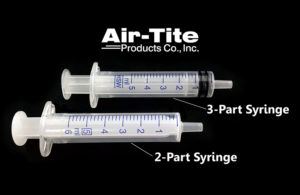Syringes remain an integral part of the medical industry, yet they are often an afterthought in the R&D or production phase.
William Foley, Air-Tite Products

It’s possible to manufacture a syringe from many different materials – metal, borosilicate glass, COP, COC, and Zylar, to name a few. However, the more common syringes are plastic disposables for single use. Disposable syringes allow the user to worry less about cross-contamination, particularly important when dealing with toxic or infectious materials. Most of the single-use, disposable syringes are made of polypropylene. While not appropriate for every application, disposable syringes are typically an inexpensive option for many laboratory uses.
Occasionally a researcher or engineer may have difficulty identifying the source of various contaminates in their process. Sometimes the source is either the rubber or silicone oil found in common three-part syringes. If that becomes apparent in your process, there may yet remain another low-cost option by way of a two-part syringe. Two-part syringes are slightly different because they do not use a rubber tip on the plunger to create a vacuum seal. Instead, these syringes have been specifically designed to not introduce additional materials such as rubber or even silicone oil.
When you see black rubber present on the tip of the plunger in a syringe, that syringe typically requires a lubricant (most often silicone oil) to prevent the rubber from “grabbing” the sides as it slides up and down the barrel. These are the most common type of disposable syringes, known as three-part. Typically, when someone asks for a disposable syringe, they are requesting this type of syringe. Alternatively, these syringes may be referred to as regular, conventional, standard, or RTP (for rubber tip plunger) syringes. These syringes are popular for their smooth gliding motion, low cost, and wide variety of functions. The rubber gasket on the tip plunger acts as a sealant against the barrel and creates a vacuum for drawing material into the syringe. To prevent the sticking of the rubber against the solid material of the barrel, a manufacturer sprays the lubricant into the barrel during the assembly of three-part syringes. While standard three-part syringes are used for a much wider range of applications, two-part syringes offer distinct advantages for some applications.
To circumvent the need for an added lubricant, two-part syringes (known as Norm-Ject or Henke-Ject) utilize a precisely engineered, slightly oversized plunger head that expands the barrel to create the vacuum. These two-part syringes are made of a polypropylene barrel and a polyethylene plunger. The design allows for a smooth gliding plunger that maintains vacuum pressure without the rubber gasket. These syringes are useful for many sensitive applications. Common applications include chromatography, ophthalmics, industrial solvents, glues, paints and various laboratory applications.
In addition to the two-part versus three-part considerations, it’s possible to purchase both options in several different formats including luer lock, luer slip, oral tip, catheter tip, centric, eccentric, sterile, unsterile, bulk, mini-bulk, as well as by box or by case. Luer lock and luer slip syringes accept a standard hypodermic needle if intended for injection or fluid transfer. For higher volume applications, manufacturers can also provide custom solutions such as ungraduated, unassembled, unique colors, light-restricting, special volumetric markings or adding company logos.
When in doubt, call a company of syringe and needle experts, let them know what you are looking for and see if they have an off-the-shelf option or a custom solution for you. A good supplier will guide you in the right direction, even if they don’t offer the solution you seek.
William (Will) Foley has been active in the medical device industry since 2001, with experience in a variety of roles. He has worked for Air-Tite Products for the last four years, where he is currently the VP of sales and marketing.
The opinions expressed in this blog post are the author’s only and do not necessarily reflect those of MedicalDesignandOutsourcing.com or its employees.

